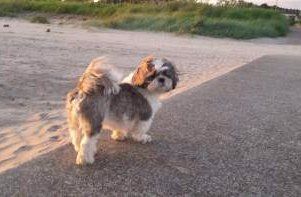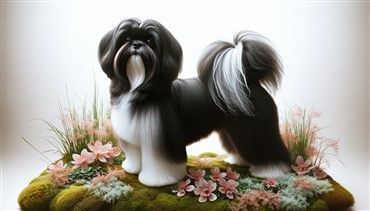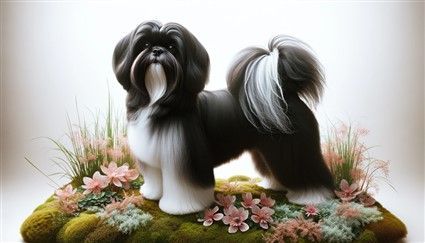Shih Tzu Tails
Overview
Please note: AllShihTzu is reader-supported, and some of the product suggestions on this page are affiliate links. As an Amazon Associate we earn from qualifying purchases. This is at no extra cost to you and helps keep this site running.
Shih Tzu Tail Set: Show vs Pet
Show: The AKC's breed standard for the Shih Tzu is: Tail - Set on high, heavily plumed, carried in curve well over back. Too loose, too tight, too flat, or too low set a tail is undesirable and should be penalized to extent of deviation.
In simpler terms, this means that a Shih Tzu's tail should start high up on its back and have lots of hair, forming a nice curve that arches over the body. If the tail hangs too loosely, is curled too tightly, lays too flat, or starts too low on the body, it's not what the standard looks for and could affect the dog's score in a show. The degree to which the tail differs from this ideal will determine how much it counts against the dog.
Pet: For a pet Shih Tzu, not being in the show ring, the tail's appearance can vary more widely than the strict standards set for competition. Typically, a Shih Tzu's tail is still set high on its back and may carry a plume of hair, but the degree of the curve over the back can differ. Some Shih Tzu dogs may have tails that curl loosely, while others might have tails that don't arch as prominently. The tail might not always be as heavily plumed or perfectly positioned as described in show standards, depending on grooming, genetics, and overall health.
In everyday life, the appearance of a Shih Tzu's tail is more about health and happiness than meeting specific aesthetic criteria. A lively Shih Tzu will wag their tail energetically, regardless of its curve or plume. So, while a show Shih Tzu's tail is a work of art crafted to meet precise standards, a pet Shih Tzu's tail is more about expression and character, often reflecting the dog's mood and well-being rather than conforming to a breed standard.
Interpreting the Tail Language of a Shih Tzu
For a Shih Tzu, a breed known for its distinctive tail carriage over its back, tail positions can reveal much about their mood and health. This breed's tail set is not merely a breed characteristic but an expressive tool, providing insights into their emotional state and well-being. This is what various tail positions can communicate:
- Tail Curled Over the Back: This is the typical posture of a Shih Tzu's tail, indicating a state of contentment, confidence, and alertness. When a Shih Tzu holds their tail high and curled over its back, it usually means they are in a good mood, feeling secure and happy in their environment.
- Tail Relaxed and Lowered: If the tail is relaxed and not held as tightly over the back, it can suggest a state of calmness or neutrality. This position may indicate that the Shih Tzu is relaxed, comfortable, and not feeling particularly alert or engaged.
- Subtly Lowered Tail: For the Shih Tzu, a breed characterized by a tail that naturally curls over the back, a full tuck under the body as seen in other dog breeds is less common due to their anatomical structure. Instead, a Shih Tzu may show signs of fear, anxiety, or submission through a subtly lowered tail. Rather than curling over the back, the tail might slightly uncurl and lower towards the body, but not fully tuck under. This more subdued gesture still communicates discomfort or a desire to avoid conflict, indicating that the dog feels uneasy or threatened in certain situations.
- Wagging Tail: A wagging tail is the body language that signifies joy or excitement. The speed and manner of the wag can further refine what emotion the dog is experiencing.
- Stiff Tail: A tail that is stiffly held over the back, especially if combined with a rigid body posture, can indicate alertness or aggression. This position may suggest that the Shih Tzu is focusing intently on something or might be feeling defensive.
Are Shih Tzu dogs supposed to have curled tails?
Can a Shih Tzu's Tail Set be Hereditary?
Do Shih Tzu Dogs Have Docked Tails?
Is it Okay to Shave a Shih Tzu's Tail?
Can I Shave the Hair Right Under My Shih Tzu's Tail?

If a Shih Tzu Chews on the Tip of Their Tail:
If a Shih Tzu Suddenly Stops Moving Their Tail:
If a Shih Tzu dog stops moving their tail, it can be a sign of various underlying issues, ranging from physical problems to emotional distress. Here are some reasons why this may occur:
- Cold Weather: In very cold temperatures, dogs may hold their tails closer to their bodies to conserve heat, resulting in less tail movement. This is a natural response to maintain body temperature.
- Injury or Pain: If a dog has injured their tail or is experiencing pain in or around the tail area, they may stop moving it to avoid further discomfort. Tail injuries can occur from accidents or even overexertion during play.
- Depression: Similar to humans, dogs can experience depression, which may cause them to become less active and show less interest in things they usually enjoy, including wagging their tail. Signs of depression in dogs can include changes in appetite, sleep patterns, and a general lack of enthusiasm for play or interaction.
- Emotional Distress: Dogs communicate their emotions through their tails. A dog that is scared, anxious, or depressed might hold their tail still as a sign of their emotional state. This can be a temporary response to a stressful situation or a sign of a deeper issue.
- Fatigue or Illness: Just like humans, dogs can have days where they feel tired or under the weather. A dog might not move their tail as much if they're feeling lethargic due to illness or exhaustion.
- Anal Gland Issues: Dogs have anal glands that can sometimes become impacted or infected, causing discomfort or pain. When experiencing anal gland issues, a dog might stop wagging their tail to avoid exacerbating the pain and discomfort. You might also notice them scooting or licking the area excessively.
- Back Problems: Dogs suffering from back problems, including issues like herniated discs, arthritis, or spinal injuries, may reduce their tail movement to minimize pain. These conditions can affect the spine's mobility and the nerves that control tail movement, leading to stiffness, reduced mobility, or paralysis in severe cases.
Shih Tzu Tail Injury:
Tail injuries in Shih Tzu dogs can stem from a variety of incidents and can affect their ability to express emotions and maintain balance. Recognizing the signs and knowing how to respond can make a significant difference in your little guy or gal's recovery.
Signs of Tail Injury: First, it's crucial to recognize the symptoms of a tail injury in your Shih Tzu. These signs can include:
- Limpness or Inability to Wag: A clear indication of discomfort or injury.
- Swelling or Visible Bruises: These are physical signs of trauma to the tail.
- Excessive Licking or Biting: At the tail area, suggesting pain or irritation.
- Whimpering or Vocalizing: Especially when the tail is touched or moved.
Common Causes: Understanding how your Shih Tzu might have injured their tail is key to preventing future incidents. Typical causes include:
- Accidents: Such as getting the tail caught in doors or experiencing falls.
- Animal Bites: Can occur during fights or interactions with other pets.
- Overexertion: Sometimes, vigorous wagging can lead to muscle strain.
- Environmental Hazards: Like encountering thorns, burrs, or harsh weather conditions.
Home Treatment: If the injury appears minor, there are several steps you can take at home to help your Shih Tzu feel better. These include:
- Rest: Reducing physical activity to prevent aggravating the injury.
- Cold Compress: Applying a cold compress to the injured area to reduce swelling.
- Clean Wounds: Cleaning minor cuts with pet-safe antiseptic solutions.
- Pain Relief: Always consult with your vet before administering any OTC medication for pain relief.
When to See a Vet: Some situations require professional veterinary care to ensure proper healing. Seek a vet if you notice:
- Severe Pain: If your Shih Tzu shows signs of significant distress.
- Open Wounds: Deep cuts or profuse bleeding need professional attention.
- Signs of Infection: Such as redness, swelling, or a foul odor from the injury.
- Inability to Move the Tail: This could indicate a fracture or serious nerve damage.
Important Considerations: Promptly addressing tail injuries is crucial for a Shih Tzu’s well-being, given the importance of the tail in their communication and physical balance. Gentle care and attentiveness to their needs during recovery are paramount.
Let's be email friends...
More Articles for You:
Help a Shih Tzu Live a Long Life - Steps you can start implementing today that will directly affect your sweet Shih Tzu's life span. Most are very easy to work into a pup or dog's typical care routine.
Shih Tzu Dental Care - Oral health is at the top of concern for the Shih Tzu breed and all pet parents should be actively cleaning their Shih Tzu's teeth. See our top tips to keep your little guy or gal's teeth clean, to prevent infections and future tooth loss.
10 Must-Haves Under 10 Smackaroos - On a budget but still want the best for your Shih Tzu? These clever care items are all easy on the wallet and big on everyday comfort, convenience and cuteness.
Shih Tzu Eye Care - A helpful guide for keeping your Shih Tzu's eye area clean and free of eye 'sleep' and other irritants. This also leads to articles regarding tear stains and eye issues.
The Best Toys for a Shih Tzu - From durable chew toys for teething pups with itchy gums to companion toys for Shih Tzu that spend time home alone, this article covers all the best types of toys and recommendations.





